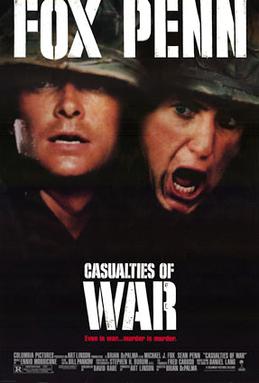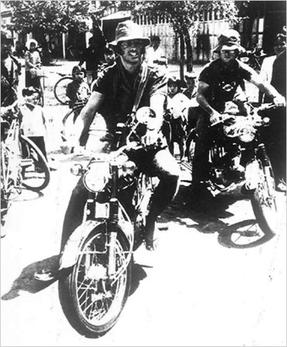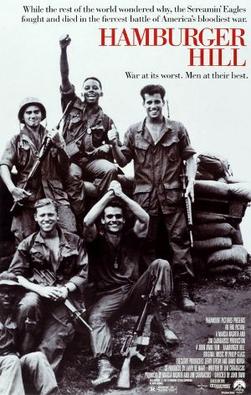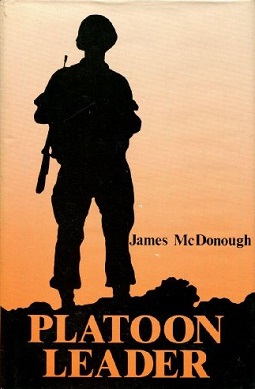
Platoon is a 1986 American war film written and directed by Oliver Stone, starring Tom Berenger, Willem Dafoe, Charlie Sheen, Keith David, Kevin Dillon, John C. McGinley, Forest Whitaker, and Johnny Depp. It is the first film of a trilogy of Vietnam War films directed by Stone, followed by Born on the Fourth of July (1989) and Heaven & Earth (1993). The film, based on Stone's experience from the war, follows a new U.S. Army volunteer (Sheen) serving in Vietnam while his Platoon Sergeant and his Squad Leader argue over the morality in the platoon and of the war itself.

The First Indochina War was fought between France and Việt Minh, and their respective allies, from 19 December 1946 until 21 July 1954. Việt Minh was led by Võ Nguyên Giáp and Hồ Chí Minh. Most of the fighting took place in Tonkin in Northern Vietnam, although the conflict engulfed the entire country and also extended into the neighboring French Indochina protectorates of Laos and Cambodia.

Casualties of War is a 1989 American war drama film directed by Brian De Palma and written by David Rabe, based primarily on an article written by Daniel Lang for The New Yorker in 1969, which was later published as a book. The film stars Michael J. Fox and Sean Penn and is based on the events of the 1966 incident on Hill 192 during the Vietnam War, in which a Vietnamese woman was kidnapped from her village by a squad of American soldiers, who raped and murdered her. For the film, all names and some details of the true story were altered.

Sean Leslie Flynn was an American actor and freelance photojournalist best known for his coverage of the Vietnam War.

Hamburger Hill is a 1987 American war film set during the Battle of Hamburger Hill, a May 1969 assault during the Vietnam War by the U.S. Army's 3rd Battalion, 187th Infantry, 101st Airborne Division, on a ridge of Dong Ap Bia near the Laotian border in central Vietnam. The ridge was a well-fortified position, including trenchworks and bunkers, of the North Vietnamese Army. U.S. military records of the battle refer to the mountain as "Hill 937," its map designation having been derived from the high elevation of the hill at 937 meters (3,074 ft).

We Were Soldiers is a 2002 American war film written and directed by Randall Wallace and starring Mel Gibson. Based on the book We Were Soldiers Once… and Young (1992) by Lieutenant General (Ret.) Hal Moore and reporter Joseph L. Galloway, it dramatizes the Battle of Ia Drang on November 14, 1965.

The Green Berets is a 1968 American war film directed by John Wayne and Ray Kellogg, and starring Wayne, David Janssen and Jim Hutton, based on the 1965 novel by Robin Moore. Much of the film was shot in the summer of 1967. Parts of the screenplay bear little relation to the novel, although the portion in which a woman seduces a North Vietnamese communist general and sets him up to be kidnapped by Americans is from the book.

Tigerland is a 2000 American war drama film directed by Joel Schumacher and starring Colin Farrell. It takes place in a training camp for soldiers to be sent to the Vietnam War.

The Anderson Platoon is a documentary feature by Pierre Schoendoerffer about the Vietnam War, named after the leader of the platoon - Lieutenant Joseph B. Anderson - with which Schoendeorffer was embedded. Two decades later, a sequel was released as Reminiscence.

Pierre Schoendoerffer was a French film director, a screenwriter, a writer, a war reporter, a war cameraman, a renowned First Indochina War veteran, a cinema academician. He was president of the Académie des Beaux-Arts for 2001 and for 2007.

Platoon Leader is a 1988 war film set in the Vietnam War and directed by Aaron Norris ; it stars Michael Dudikoff and Michael DeLorenzo and was filmed in South Africa. It is loosely based on James R. McDonough's memoir of the same name.

The Battle of Gang Toi was fought during the Vietnam War between Australian troops and the Viet Cong. The battle was one of the first engagements between the two forces during the war and occurred when A Company, 1st Battalion, Royal Australian Regiment struck a Viet Cong bunker system defended by Company 238 in the Gang Toi Hills, in northern Biên Hòa Province. It occurred during a major joint US-Australian operation codenamed Operation Hump, involving the US 173rd Airborne Brigade, to which 1 RAR was attached. During the latter part of the operation an Australian rifle company clashed with an entrenched company-sized Viet Cong force in well-prepared defensive positions. Meanwhile, an American paratroop battalion was also heavily engaged in fighting on the other side of the Đồng Nai River.

Platoon Leader is a memoir by James R. McDonough. It is narrated by McDonough in first person view and tells of his story in the Vietnam War as a lieutenant in command of 2nd Platoon, Bravo Company, 4th Battalion, 503rd Infantry(Airborne). It was loosely adapted into the 1988 film Platoon Leader.

Operation Bribie, also known as the Battle of Ap My An, was fought during the Vietnam War in Phuoc Tuy province between Australian forces from the 6th Battalion, Royal Australian Regiment and two companies of Viet Cong from D445 Battalion, likely reinforced by North Vietnamese regulars. During the night of 16 February the Viet Cong attacked a South Vietnamese Regional Force compound at Lang Phuoc Hai, before withdrawing the following morning after heavy fighting with South Vietnamese forces. Two hours later, a Viet Cong company was reported to have formed a tight perimeter in the rainforest 2 kilometres (1.2 mi) north of Lang Phuoc Hai, near the abandoned hamlet of Ap My An. In response, the Australians deployed a quick reaction force. Anticipating that the Viet Cong would attempt to withdraw, as they had during previous encounters, forces from the 1st Australian Task Force were inserted to block the likely withdrawal route in the hope of intercepting and destroying them.

A Face of War is a 1968 documentary about the Vietnam War The New York Times called it "one of the great Vietnam documentaries.". The film was produced and directed by Eugene S. Jones (1925-2020) a Korean War news photographer who rose to fame alongside his twin brother Charles Jones. The Jones brothers initially worked for the Washington Times-Herald before moving to NBC and traveling to Korea, where they made the first films from jet fighters in combat and the only films of the Inchon landing. Eugene was hired by NBC Special Projects, becoming a Today Show producer in the late 1950s before working on A Face of War.

The New Year's Day battle of 1968 was a military engagement during the Vietnam War in Tây Ninh province that began on the evening of 1 January 1968. It involved units assigned to the U.S. 25th Infantry Division and two regiments of the People's Army of Vietnam (PAVN). The battle was known as the Battle of Fire Support Base Burt, or the Battle of Suoi Cut. This is not the same location as Suối Cắt village in northern Vietnam.

The Battle of Suối Châu Pha was fought during the Vietnam War between Australian troops and the Việt Cộng. The battle took place during Operation Ballarat, an Australian search and destroy operation in the eastern Hát Dịch area, north-west of Núi Đất in Phước Tuy province. Following a covert insertion the day before which had caught a number of Việt Cộng sentries by surprise, A Company, 7th Battalion, Royal Australian Regiment had patrolled forward unaware of the presence of a large Việt Cộng main force unit nearby. Clashing with a reinforced company from the Việt Cộng 3rd Battalion, 274th Regiment, a classic encounter battle ensued between two forces of roughly equal size. Fought at close quarters in dense jungle amid a heavy monsoon rain, both sides suffered heavy casualties as neither was able to gain an advantage. Finally, after a battle lasting several hours, the Australian artillery proved decisive and the Việt Cộng were forced to withdraw, dragging many of their dead from the battlefield after having suffered crippling losses.

Leathernecks is a 1989 Italian Vietnam war film directed by Ignazio Dolce and starring Richard Hatch.

The Battle of Ben Het was a North Vietnamese armored assault on the Ben Het Special Forces Camp. It was the only tank battle between the United States and North Vietnam during the Vietnam War.


















